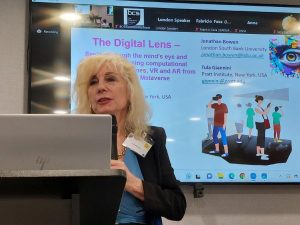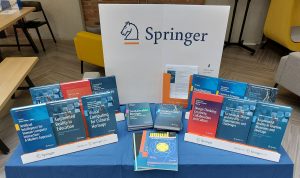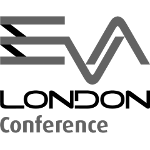
Symposium presentation during EVA London 2023
EVA London 2023 Symposium
Monday, 10 July 2023
The Digital Lens
See also an open-access summary paper in the EVA London 2023 conference proceedings under DOI 10.14236/ewic/EVA2023.1
| Tula Giannini (Chair) | Jonathan P. Bowen (Co-Chair) |
| Pratt Institute School of Information New York, USA http://sites.google.com/view/tgiannini |
London South Bank University School of Engineering London, UK http://www.jpbowen.com |
| giannini@pratt.edu | jonathan.bowen@lsbu.ac.uk |
| Terrence Masson | Giuliano Gaia | Graham Diprose |
| School of Visual Arts New York, USA https://www.terrencemasson.com |
InvisibleStudio Milan, Italy https://www.invisiblestudio.net/founders |
Independent, UK https://linkedin.com/in/graham-diprose-a047004 |
| tmasson@sva.edu | giuliano@invisiblestudio.it | grahamdiprose@gmail.com |
This Symposium explores themes of digital art and photography with respect to developments in computational culture. The three speakers are all contributors to a newly proposed book on the arts and computational culture. The paper provides some background to the concept of the Metaverse in the context of digital culture. Then each participant provides a statement from their viewpoint and experience. These cover diverse issues based on the varied backgrounds and expertise of the contributors.
After the presentations, there will be a discussion session between the presenters and the audience, chaired by Tula Giannini.

Springer book stand
Note also that a bookstand organised by Helen Desmond of Springer is also planned, especially covering the Springer Series on Cultural Computing (e.g., see Museums and Digital Culture).
Introduction
The Symposium includes three invited speakers at the EVA London 2023 Conference. It continues a series from the previous six EVA London Symposiums held since 2016.
The Symposium series initially started in association with the Pratt Institute London Summer School, with an emphasis on digital culture and “digitalism” or “digitality”. A collaboration with the Royal College of Art developed, providing an artistic and philosophical angle to the Symposium. Aspects of digital culture continue in this year’s Symposium, which considers the theme of the “digital lens”. The speakers for this 2023 Symposium come from varied backgrounds, bringing their own perspectives to the overall theme. All are chapter authors for a planned book on the arts and computational culture, due to appear in the Springer Series on Cultural Computing.
The Digital Lens
Looking through the digital lens, it integrates with the human lens of the mind’s eye, reflecting the digital self and its interpretations of extended reality (XR).
As Metaverse technology develops it turns more to wearable technology. For example, Apple is working on new Apple Glasses that “will make it easier to integrate our virtual worlds with the real world, like an extended reality,” making digital seeing 3D and feel more intuitive, as opposed to staring down at a flat screen. A recent US Copyright ruling shows the importance of the interplay between the human and digital lens, stating that for generative works, “the Office asks applicants if the included AI elements are the result of ‘mechanical reproduction’ or of an author’s ‘own original mental conception’”. Along with “mental conception” human interpretation distinguishes the blending of the digital lens with that of the mind.
We ask OpenAI’s highly successful ChatGPT AI chatbot (Chat Generative Pre-trained Transformer, https://chat.openai.com/chat): “Although generative art, text to image, is having great success, why is image to text so far behind?” According to ChatGPT, the reason is:
“image-to-text tasks involve interpreting an existing image and describing its contents in natural language. This requires the AI model to understand the semantic meaning of various visual elements in the image, such as objects, scenes, and relationships between them. This is a challenging problem for AI models because it requires them to capture the nuances of human language and the diverse ways in which people describe images.”
Addressing these issues is Microsoft’s new Visual ChatGPT (Economic Times 2023), which uses OpenAI’s GPT (Generative Pre-trained Transformer) Large Language Model and Microsoft’s Prometheus model. Unlike other AI image generators that use a “Visual Foundation Model” (VFM), Visual ChatGPT has multiple VFMs associated with a flexible GPT model through a “Prompt Manager”. Visual ChatGPT provides AI tools that are designed to interact with human creativity and imagination.
As 21st-century life is increasingly embedded in computational culture, new ways of thinking about the originality and authenticity of digital methods, especially as we head to the Metaverse where avatars look, speak and act exactly like their real counterparts, blurring with virtual worlds akin to a dream-like existence. With rapid advances in neuroscience using AI tools and technology, the digital lens gets increasingly powerful and central to our understanding of human and artificial neural networks making AI more than ever a human factor.
Concurrently, scientists are seeking novel approaches to deep learning (DL) in AI and human imagination, with the conclusion that the dominant paradigm of AI today is unlikely to lead to truly natural general intelligence and that something like a biologically inspired framework is needed. How will artists lead this new revolution in human creativity, art, and digital intelligence (DI)?
Recent developments in Artificial Intelligence (AI) have enabled generative art to be produced automatically and interactively. A leading piece of software enabling this is Open AI’s DALL.E 2 (https://openai.com/product/dall-e-2).
We all now inhabit a post-Covid, post-digital world. Each participant interprets the symposium theme of the digital lens in the context of their own life and work. Then looking from the present into the future, how will current transformations develop in the future?
Speaker Statements
Terrence Masson
School of Visual Arts, New York, USA
Preparing Students for the New Computer Arts Landscape: An artist’s journey
I entered the field of computer graphics in the mid-1980s, a time of rapid development for computer animation in film and television. As the computer arts landscape continues to evolve rapidly, it is essential to prepare students for the new and emerging technologies that are about to revolutionise the world of art and design. As an artist who has journeyed through this transformational period, I understand the importance of learning and mastering digital tools to create compelling and innovative artworks.
To prepare students for the new computer arts landscape, it is crucial to not only focus on developing skills in software and application technologies, but equally essential to teach them about the ethical considerations of using technology in art, such as copyright laws and the impact of technology on society. Students should always be encouraged to experiment, collaborate, and explore new artistic forms and mediums, not only with animation but as interactive installations, immersive experiences, and digital sculptures. With these new AI technologies, students can potentially create art that engages and inspires audiences in unprecedented ways.
This presentation visualises my animation production and education leadership career path over 30 years, now passing through the present, a moment of computational innovation in computer arts during radical change, challenging both artists and educators to envision new paths forward.
Biography
Terrence Masson is an educator and computer graphics raconteur with 30 years of production and education leadership experience. As an animation and visual effects artist and producer, his work includes live-action, animated feature and short animated films, VR/AR (Virtual/Augmented Reality), video games and ride films. His book CG101: A Computer Graphics Industry Reference is a standard text worldwide for both studio executives and students, in print (1st edition, 1999; 2nd edition, 2007) and online at www.historyofcg.com.
Terrence came up through the ranks on more than 20 feature films including Hook, True Lies, Interview with the Vampire and three Star Wars movies; along with supervising numerous interactive projects such as SimCity4, Bruce Lee, Batman Dark Tomorrow and Alter Echo. He developed the original CG animation method for SouthPark in 1996 and his short film Bunkie & Booboo won first place in the World Animation Celebration in 1998.
An active lecturer, Terrence has enjoyed speaking at over a hundred international venues as a keynote speaker and panel moderator, in addition to being on camera for multiple seasons of the History Channel docudramas Ancient Aliens and UFO Hunters. An active volunteer with SIGGRAPH since 1988, Terrence served as the 2006 Computer Animation Festival Chair, SIGGRAPH 2010 Conference Chair and ACM SIGGRAPH Outstanding Service Awards Chair. Terrence is a member of the Producers Guild of America, the Visual Effects Society and a past ACM Distinguished Lecturer. He has been involved with the FMX Conference on Animation, Effects, Games and Immersive Media since 1999 and the VIEW Conference since 2010.
Giuliano Gaia
InvisibleStudio, Milan, Italy
Augmented Reality in Digital Art: Case histories and future directions
Any lens means that we are not seeing reality “as it is”; in fact our eyes are lenses too, offering a specific angle on reality. Augmented Reality (AR) is just an evolution of this basic fact of life; we are simply adding extra layers to the ones already given by our way of perceiving and interpreting the world around us.
The real change of this “Digital Lens” compared to the traditional lenses (optical or figurative) is centralisation and interoperability. Google and Facebook (now Meta) were the first companies ever to have a near-total knowledge of the lives, interests and relationships of billions of individuals worldwide. Augmented Reality will mean the possibility for those companies, or other companies or states, to gain unprecedented access to what billions of individuals will be looking at, and to alter what they see. Objects could be added or erased, even without our knowledge.
AR and XR (eXtended Reality) are still in their infancy due to the absence of usable enough devices, but artists and intellectuals alike have to prepare themselves for the future, because, as ChatGPT showed, technological lapses are happening all the time. Therefore we will explore together how AR has been used by artists so far, and how it could evolve both as an artistic and interpretation tool.
Biography
Giuliano Gaia has been working in the field of digital communications for museums since 1995 and is the co-founder with Stefania Boiano of InvisibleStudio, a studio based in London and Milan bringing technological innovation to museums, creating new cultural experiences and experimenting with new formats for university and corporate training aimed at clients worldwide, like Bayer, ING Direct, Malta Tourism Authority, McAfee, Sony, MIT, to name a few.
Before InvisibleStudio, Giuliano built the first website for WWF Italy, founded the New Media Department at the Science Museum of Milan and created Virtual Leonardo, an online 3D interactive world that anticipated Second Life and was mentioned in the New York Times. Giuliano is an adjunct professor in Digital Communication at IULM University in Milan.
Graham Diprose
Independent, UK
Digital Preservation and Access: Photography past, present, and future
Photographic images from over the past two centuries, have offered us all a ‘unique and believable’ documentary record of our history, culture, and beliefs. Early photographers strove to achieve monochrome image longevity. It was more of a surprise that the colour films from the past hundred years, were at greater risk of fading and disintegration than the silver gelatine monochrome plates from earlier generations.
Today’s digital imaging offers a much simpler means to capture and share our photographs. However, redundant software and file formats, data storage failure and ‘bit rot’ literally breaking down data over time, make this the most fragile media of all. Even if an artist finds a suitable archive for their work, supposing in the future that there is no funding for further vital migration, or the archive takes newer material, considered more important? Our, yet unborn, great-grandchildren may have very different aesthetic tastes and not necessarily value our personal digital collection.
This presentation proposes that museums and artists should revisit a proven centuries-old technology of pigment images on acid-free paper via digital inkjet printing, or making short-run self-publish books, as ‘a safer insurance’ for the very long-term archiving of the most vital parts of their research and collections.
Biography
Graham Diprose is a photographer and author. During the 1970s and 1980s, he worked as a freelance advertising photographer based in central London and taught photography part-time. During the 1980s and 1990s, he became a full-time lecturer at the London College of Communication and later Lead Tutor in Photography within the Faculty of Design.
More recent work has involved large research projects concerning the history of the River Thames and an international textbook for Thames & Hudson published in the UK, US, and Chinese Mandarin. Graham retired from the role of Lead Tutor at Speos Institute, London, to work on researching and outputting self-publishing books mapping the detailed ancestry of his entire family.
Summary
We live in a world where the digital lens is at the heart of human communication and creativity, and in the hands and minds of billions of people across the globe. As the Metaverse comes to life in extended reality, while our bodies are embedded with digital devices that augment our human powers, how will artists respond to this new world where digital imagination rules? Propelled by big tech and social media, while surveilled by governing bodies, who will fight for individual freedoms for artists, and diverse voices across the globe? We can already see that AI in the arts is opening the creative professions to rising numbers of participants while gatekeepers recede, making way for new educational opportunities to emerge. Looking through the digital lens, we visualise the arts as we position ourselves to travel new exciting and productive paths forward from planet Earth to the Metaverse, we imagine our digital future.
Further online information concerning the EVA London 2023 Conference programme is available under:
http://www.eva-london.org/eva-london-2023/programme/
